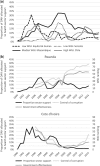Sector-wide or disease-specific? Implications of trends in development assistance for health for the SDG era
- PMID: 29351607
- PMCID: PMC5886162
- DOI: 10.1093/heapol/czx181
Sector-wide or disease-specific? Implications of trends in development assistance for health for the SDG era
Abstract
The record of the Millennium Development Goals broadly reflects the trade-offs of disease-specific financing: substantial progress in particular areas, facilitated by time-bound targets that are easy to measure and communicate, which shifted attention and resources away from other areas, masked inequalities and exacerbated fragmentation. In many ways, the Sustainable Development Goals reflect a profound shift towards a more holistic, system-wide approach. To inform responses to this shift, this article builds upon existing work on aggregate trends in donor financing, bringing together what have largely been disparate analyses of sector-wide and disease-specific financing approaches. Looking across the last 26 years, the article examines how international donors have allocated development assistance for health (DAH) between these two approaches and how attempts to bridge them have fared in practice. Since 1990, DAH has overwhelmingly favoured disease-specific earmarks over health sector support, with the latter peaking in 1998. Attempts to integrate system strengthening elements into disease-specific funding mechanisms have varied by disease, and more integrated funding platforms have failed to gain traction. Health sector support largely remains an unfulfilled promise: proportionately low amounts (albeit absolute increases) which have been inconsistently allocated, and the overall approach inconsistently applied in practice. Thus, the expansive orientation of the Sustainable Development Goals runs counter to trends over the last several decades. Financing proposals and efforts to adapt global health institutions must acknowledge and account for the persistent challenges in the financing and implementation of integrated, cross-sector policies. National and subnational experimentation may offer alternatives within and beyond the health sector.
Figures




References
-
- Allen L. 2017. Non-communicable disease funding. The Lancet Diabetes & Endocrinology 5: 92. - PubMed
-
- Allen L. 2016. Why is there no funding for non-communicable diseases? Journal of Global Health Perspectives. https://ora.ox.ac.uk/objects/uuid:3fe582f2-f4c7-46ad-9e4d-26ac33add7bb.
-
- Beaglehole R, Bonita R, Horton R. et al. 2011. Priority actions for the non-communicable disease crs. The Lancet 377: 1438–47. - PubMed
MeSH terms
Grants and funding
LinkOut - more resources
Full Text Sources
Other Literature Sources
Medical

